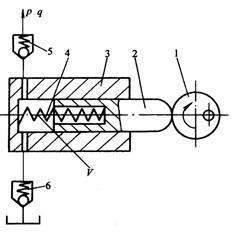
Privacy statement: Your privacy is very important to Us. Our company promises not to disclose your personal information to any external company with out your explicit permission.
Hydraulic pumps may have many friends are unfamiliar, in fact, the hydraulic pump is the core component of the hydraulic system, according to the structure can be divided into gear pumps, piston pumps, vane pumps and screw pumps. In order to let everyone know about the hydraulic pump below, Xiaobian will introduce the working principle, types and main technical parameters of the hydraulic pump.
How does the hydraulic pump work?
The following figure shows the working principle diagram of the hydraulic pump. The plunger 2 is pressed against the eccentric wheel 1 under the action of the spring 4. When the motor drives the eccentric wheel to rotate, the plunger 2 and the pump body 3 form a sealed chamber V. The volume alternates. When the plunger moves to the right, the volume of the sealed chamber V increases to form a partial vacuum. The oil in the oil tank under the action of the atmosphere enters the sealed chamber V through the one-way valve 6 to achieve oil absorption; on the contrary, when V is changed greatly Hours, the oil is squeezed and pressed into the system through the one-way valve 5 to achieve pressure oil. The motor drives the eccentric to rotate continuously, and the hydraulic pump continuously sucks and presses oil. The hydraulic pump is used to achieve oil absorption and pressure through the change of the seal chamber. The amount of oil discharged depends on the amount of change in the seal chamber, which is also called the volume pump.

Hydraulic pump working principle diagram
Key points: The necessary conditions for the normal operation of the hydraulic pump are: (1) has a sealed volume; (2) the sealed volume can alternately change; (3) there should be an oil distribution device; (4) the surface of the fuel tank is connected to the atmosphere at the time of suction.
It is not difficult to understand the working principle of the hydraulic pump. If the medical syringe works similarly, the syringe sucks the liquid, that is, the pump sucks oil, and the syringe pushes outward, which is the oil pressure process of the pump.
Type of hydraulic pump
1, according to whether the flow can be adjusted can be divided into: variable pump and quantitative pump. The output flow can be adjusted according to the needs of the variable pump, the flow can not be adjusted, known as the quantitative pump.
2. According to the commonly used pump structure in the hydraulic system, it is divided into three types: gear pump, vane pump and plunger pump.
Gear pumps: Smaller in size, simpler in structure, less stringent in terms of cleanliness of oil, and cheaper in price; however, the shaft of the pump is subject to unbalanced forces, causing serious wear and leakage.
Vane pump: Divided into double acting vane pump and single acting vane pump. This pump has uniform flow, smooth operation, low noise, higher pressure and volumetric efficiency than gear pumps, and a more complex structure than gear pumps.
Piston pump: high volumetric efficiency, small leakage, can work under high pressure, mostly used for high-power hydraulic system; but the structure is complex, the material and processing precision are high, the price is expensive, and the cleanliness of the oil is high.
The plunger pump is generally used when the gear pump and the vane pump cannot meet the requirements. There are some other forms of hydraulic pumps, such as screw pumps, but applications are not as common as the above three.
The main technical parameters of the hydraulic pump
1. Displacement of the pump (mL/r): The volume of liquid that can be pumped out per revolution of the pump
2. The theoretical flow rate of the pump (L/min): The maximum flow rate that can be discharged by the pump per unit time obtained by the calculation method at the rated rotation speed.
3, the pump's rated flow (L / min): Under normal working conditions, to ensure that the pump can run for a long time the maximum output flow
4、Pump rated pressure (Mpa): Under normal operating conditions, the maximum pressure to ensure that the pump can operate for a long time
5, the pump's maximum pressure (Mpa): allow the pump in a short time over the rated pressure when the maximum operating pressure
6, the pump's rated speed (r/min): Under the rated pressure, the maximum number of turns to ensure long-term normal operation
7, the maximum number of revolutions of the pump (r/min): the maximum speed at which the pump is allowed to exceed the rated speed for a short time at rated pressure
8, the volumetric efficiency of the pump (%): the ratio of the actual output flow of the pump to the theoretical flow rate
9, the pump's total efficiency (%): pump output hydraulic power and input mechanical power ratio
10, the pump drive power (KW): Under normal operating conditions can drive the mechanical power of the hydraulic pump
The above content is the working principle, types and main technical parameters of the hydraulic pump introduced by Xiaobian for everyone. I hope everyone can have a certain understanding of the hydraulic pump after reading it. Choosing the hydraulic pump rationally and matching the suitable motor is very important for ensuring the system's working performance, reducing energy consumption and improving efficiency.
April 22, 2024
March 18, 2024
この仕入先にメール
April 22, 2024
March 18, 2024
July 03, 2023

Privacy statement: Your privacy is very important to Us. Our company promises not to disclose your personal information to any external company with out your explicit permission.

Fill in more information so that we can get in touch with you faster
Privacy statement: Your privacy is very important to Us. Our company promises not to disclose your personal information to any external company with out your explicit permission.